Camera review Panasonic Lumix DMC-FZ18 (ENG)
* 18x optical zoom with aperture of 2.8-4.2. The Leica lens allows an angle view which is equivalent to a 35mm film camera with a 28-504mm lens.
*  MEGA OIS – optical stabilizer, developed by Panasonic is a guarantee for more sharpness in pictures, even if taken with lower shutter speed. The effective compensation is from 3 to 4 levels of the exposure time. And along with the function Inteligent ISO, the probability of producing a sharper image in low light conditions is increased.
MEGA OIS – optical stabilizer, developed by Panasonic is a guarantee for more sharpness in pictures, even if taken with lower shutter speed. The effective compensation is from 3 to 4 levels of the exposure time. And along with the function Inteligent ISO, the probability of producing a sharper image in low light conditions is increased.
* Venus Engine III – ensures speed in focusing and shooting, insignificant delay of the shutter, correction of the geometric distortions with the wide-angle option of the lens, and also correction of chromatic aberrations. The measuring of light is also very precise.
* The system for recognizing human face ( Face Detect) works perfectly when you need to have exact focus with portrait photography.
* Fast writing (2sec) in Raw format, ensures sufficient work with the image in Raw with the highest possible quality
Main specifications :
* 8.0 megapixels (3264x2448), CCD , 1/2.5"
* Leica DC Vario Elmarit
* 18 x optical zoom, 2.8-4.2 (4.6-82.8 mm equiv. 28-504 mm)
* 23 x optical zoom with resolution 5 mp, 29x optical zoom with 3 Mpix
* MEGA OIS – optical image stabilizer
* 1sm super macro
* 100, 200, 400,800,1600 ISO(3200ISO low resolution) and auto
* auto and manual WB, 2-axis adjustable
* AF, MF and Face Detect AF
* PASM + scenery
* exposure compensation and exposure bracketing
* live histogram
* shutter speed 60sec - 1/2000sec
* file formats : JPEG, RAW, RAW+JPEG
* move clips: 640x480, 848x480 , 30 fps
* Continuous shooting : 2fps
* 2.5 " TFT-LCD
* 0.44" Color EVF ,188000 Pix
* Li-Ion Battery Pack
* dimensions 118x75x88
* weight 360 g
DMC-FZ18 is the first Panasonic model with a zoom lens - equivalent to 28-504mm for a 35mm film camera. Indeed such numbers in combination with aperture of 2.8-4.2 sound almost impossible to photographers of older generations, who can understand the weight and size if those features were to be applied to a 35mm film format. Actually a zoom lens of such range and aperture has never been developed for 35mm film format, because of the possible weight which would amount to the weight of a kitchen cupboard. In addition, when I was testing the new Panasonic model, it was surreal that I could take out of my pocket a camera with a 28-504/2.8-4.2 lens. I should also mention that a X1.7 teleconverter can be attached additionally.
understand the weight and size if those features were to be applied to a 35mm film format. Actually a zoom lens of such range and aperture has never been developed for 35mm film format, because of the possible weight which would amount to the weight of a kitchen cupboard. In addition, when I was testing the new Panasonic model, it was surreal that I could take out of my pocket a camera with a 28-504/2.8-4.2 lens. I should also mention that a X1.7 teleconverter can be attached additionally.
In fact FZ18 is the successor of the widely known and discussed single-digit compact ultra zoom series of Panasonic. It began in 2002, when the brand announced the first 2mp representative of this series FZ-1. It had the unique 12 rate vario with a fixed aperture of 2.8 in its entire length. Then came the updates FZ-2 and 3 megapixel FZ-3, which also had lenses with fixed aperture of 2.8. After that, because of the great pursuit for increasing the pixels, the matrix also had to be increased in size, which resulted in a tiny loss of aperture in the telezoom end of the lens, because the compactness of the set had to be kept. So the models FZ4, FZ5, FZ7, FZ8 have an aperture of 3.3 in their telezoom end. FZ8 was the first compact ultra zoom model of this brand, equipped with the raw format, which allows more precise processing of the image and higher quality with large print formats. What distinguishes the FZ18 from its predecessor is not the increased number of pixels, because the difference between 7 and 8 million pixels, especially for an amateur camera is insignificant and in my opinion meaningless. The main advantage of the new model lays in the entirely new lens with considerably wider range, not only in the wide-angel end, but also in the telezoom end. 28-504mm is a serious step forward in comparison with the previous 35-420mm and while in the telezoom end there are no drastic changes, in the wide-angle end the difference is much more visible. If we have to compare the FZ18 in 3 and 5 megapixel settings with some of the older models like 3mp FZ3 and 5mp FZ5, we would notice the difference in the view angle, which with a 3mp corresponds to 28-800mm, and with 5mp to 28-645mm for a 35mm film format!!! How usable is such a range with 3mp – you would ask. You can answer that yourself by examining some examples below.
The following review will demonstrate the possibilities of FZ18 from a practical point of use, so I will examine camera behaviour in different actual shooting circumstances.
* Design and ergonomity
With its size of 118x75x88 mm and weight of 360g, the DMC-FZ18 can easily be put in the category of compact ultrazoom models. This is proved by the fact that I was able to carry the camera without any troubles in the side pocket of my jacket. The camera looks almost the same as its predecessor the DMC-FZ8 Classical design, traditional for a Panasonic. It looks like a minimized copy of a single-lens reflex camera. The positioning of the buttons is similar. On top there is a large and handy circular selector, with which the basic modes of shooting can quickly be selected, like programmed, aperture priority, shutter priority, manual, the basic automatic modes – portrait, landscape, sport, night shot, video mode and custom mode (with which you can set three different most frequently used sets of settings). For total beginners there is a special mode Ai, in which the camera works with completely automatic settings and with optimal settings (for shutter speed, aperture, iso, stabilization etc.), tries to produce a picture good enough for a family album. Of course for serious work and larger prints and precise results, that mode is not advisable.
models. This is proved by the fact that I was able to carry the camera without any troubles in the side pocket of my jacket. The camera looks almost the same as its predecessor the DMC-FZ8 Classical design, traditional for a Panasonic. It looks like a minimized copy of a single-lens reflex camera. The positioning of the buttons is similar. On top there is a large and handy circular selector, with which the basic modes of shooting can quickly be selected, like programmed, aperture priority, shutter priority, manual, the basic automatic modes – portrait, landscape, sport, night shot, video mode and custom mode (with which you can set three different most frequently used sets of settings). For total beginners there is a special mode Ai, in which the camera works with completely automatic settings and with optimal settings (for shutter speed, aperture, iso, stabilization etc.), tries to produce a picture good enough for a family album. Of course for serious work and larger prints and precise results, that mode is not advisable.
* The sensor
The sensor has 8 effective megapixels with a size of 1/2.5 inches, manufactured by Panasonic. In comparison with the DMC-FZ8 the one extra megapixel does not necessarily improve anything. The exact resolution is 3264x2448 pixels, the proportions/correlations of the frame are 4:3. If you are shooting at 5mp, only the middle of the matrix is used and the zoom lens increases 23 times. At 3mp it increases 28.7 times!
* Processor
For the DMC-FZ18 the constructors used the familiar from the FZ8 and FZ50, more powerful processor Venus Engine III. Thanks to it, the camera has better color delivery, more precise metering of light, high sensitivity up to 1600 ISO, effective noise reduction, and also a new mode for regulating the sensitivity according to the movements of the object being photographed. The delay when pushing the shutter button (without focusing) is 0,009 s, the next picture can be made after 0,8 s. The writing of files in raw format and a fast card takes only 2 s. I managed to make 26 pictures in RAW for one minute. I used manual focus so that the delay between two images was minimized. This along with the quick switching on undoubtedly makes the DMC-FZ18 one of the fastest compact digital cameras from this class.
Here I have to mention something important about the processor - responsible for removing chromatic aberrations and geometric distortions of the wide angle end of the lens. While the feature – removing chromatic aberrations is not something unexpected for a Panasonic model, the feature - straightening barrel distortions at 28mm, something I hadn’t seen before, possible in the processing of the image in the camera itself. Below you can see the same photograph, shot in RAW and JPEG. Notice the correction of the distorted edges of the picture shot in JPEG (in RAW the processor and software in the camera do not have any effect):


*Lens
The lens is Leica Vario-Elmarit with a thread for 46mm filters. High quality German optics - one of the reasons every representative of the FZ class is so successful. The 18x optical zoom 2,8-4,2/28-504mm (equivalent to 35mm classic film photography), gives a high resolution in the entire field of the image at every f point. There is a slight possibility of lower resolution at maximum focal length and f4.2 but it is not fatal. A lens with such range is not absolutely chromatic aberrations safe, those aberrations can be visible but also removable with RAW. In JPEG their removal is possible because of the processor and software in the camera. As you saw from the examples above, the same goes for the geometric distortions at maximum wide range options of the lens. In the example below you can see 100% segments of photos both in RAW and JPEG, respectively. The purple line in the contrast zone formed between the dark and light jackets of the girls is more visible in RAW and not visible at all in JPEG.

In our examples below you can see pictures at lowest and highest focal length and you can ‘feel’ the incredible possibilities of the zoom lens. I think, the popularity of the Panasonic cameras is mostly due to the technical integration with the Leica Company.
In the examples below you can see the village of Mezek, shot from the fortress Mezek at 28mm, 112mm, 504mm and 800mm (3mp mode). I have to mention that the weather was quite dark and I shot with the telezoom lens option with completely opened diaphragm. I shot like a usual amateur photographer tourist - from hand with switched on stabilizer.
28mm:
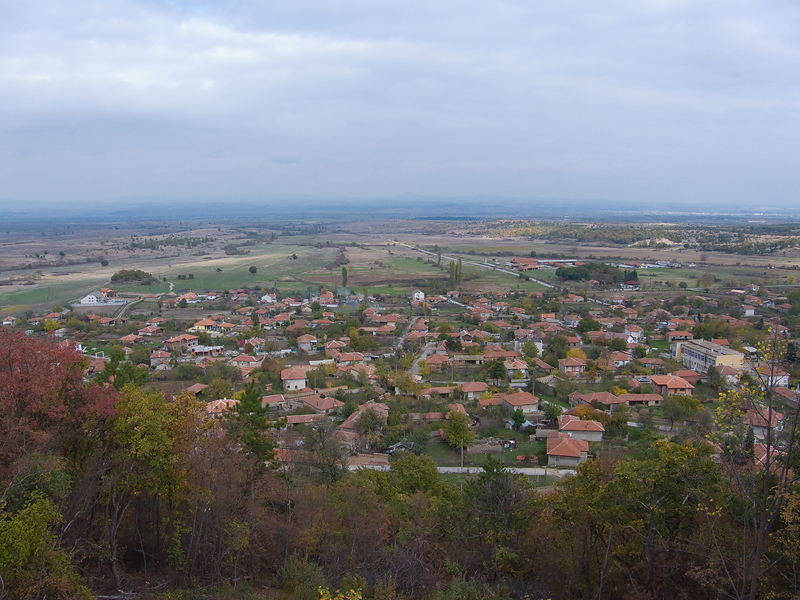
112mm:

504mm:

800mm:

Here are the crops 100% from pictures - 28mm, 112mm, 504mm:
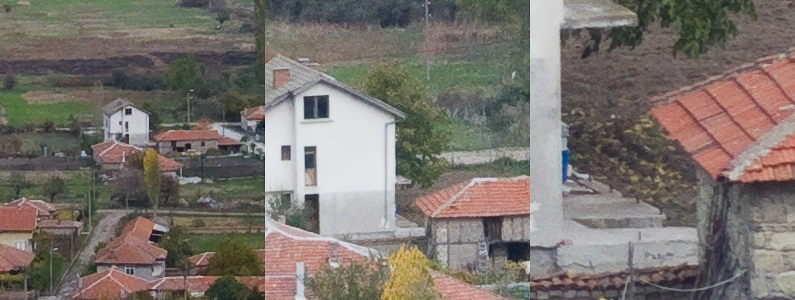
* Image stabilization :
The stabilizer of the FZ18 is the improved version of the familiar OIS with three modes – switched on, permanently on and on while shooting. With it comes the intelligent system for controlling the sensitivity of the camera. It recognizes the movements of the object and if needed increases the sensitivity, in order to produce a sharper, unsmuged image. In my opinion that is a very important feature for the not so prepared amateur. Of course in some cases the automatic choice of higher sensitivity can lower the quality of an image, which would be visible in greater enlargements of the picture. Fortunately the constructers/builders took that into consideration and made that feature switchable from on to off, something I recommend if you would enlarge the image later on. Below 15x20cm that would not be necessary. All in all the stabilizer does a fine job if we want to make a sharper high quality image without wasting time with a tripod. In many cases though, when there is hardly any light, a tripod is a must.
Here is a typical tourist sight, shot from one and the same place at 28 and 504mm. At 28mm I manage to capture the entire cathedral, but with 504mm only an interesting detail, which in the first case is too small and over-exposed to be noticed separately from the entire shot. The lighting is very low. I used sensitivity of 400ISO, and shutter speed respectively of 1/8s at 28mm and 1/50s at 504mm. Despite these crude conditions, and the lower shutter speed ,higher sensitivity, I can safely say that the photos are good for 30x40 prints. .
28mm:
 504mm:
504mm:

Crops 100% from pictures :
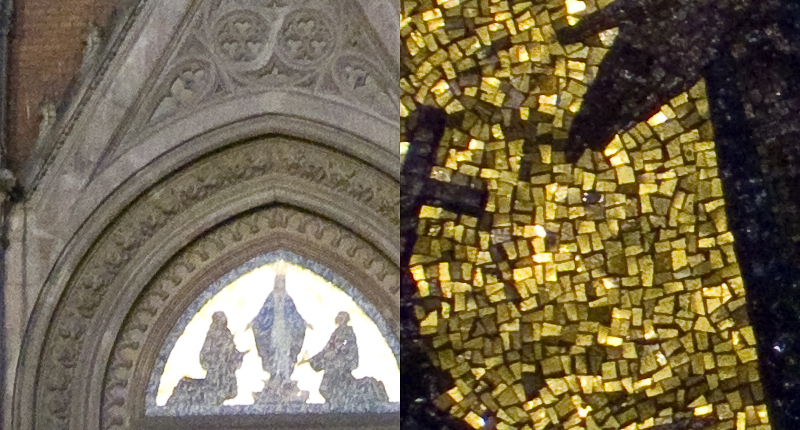
This kind of sharpness, with such low shutter speed , would be impossible without the use of an optical stabilizer and tripod
* ViewFinder and Display
A very useful view finder-display (size – 0,44 inches, resolution 188 000 pixels) extremely helpful when shooting in really bright light. Although, it’s the same as any other view finder and doesn’t give the correct idea of color or depth of field, it comes in handy for image composition. The fact that you can see a histogram in actual time of shooting is a positive. On the 2.5 inches LCD display the produced pictures can be viewed perfectly because of the 16x enlargement which gives you an idea of picture quality.
* AF nad MF
The autofocusing is controlled by a button located next to the circular selector in the top side of the camera and has three positions – automatic, macro and manual focusing. From the menu you can choose tracing autofocus. The points for autofocusing are quite sufficient: focusing on 1 point, ultrafast focusing on 1 point, focusing on 3 points, ultrafast focusing on 3 points, 9-point focusing and spot focusing, and also autofocusing with human face recognition (involves tracing) which helps a lot when shooting street portraits. When shooting at low light there is a helpful tracing light. Standard focusing is from 30cm till infinity, the macro mode is possible from 1cm. The focusing is fast and precise. The quickness of the focus in spot mode has been noticeably improved. Manual focus is not as handy or easy to use as it is with FZ50, because it is controlled not by a focusing ring but by a joystick.
The autofocus is good enough for shooting even a football game, where a lot of fast movements are involved. In such cases you cannot expect results on a professional level but just for fun or amateur photographers the camera works very good. The images below were taken during a football game held in the late afternoon. I was sitting in the back and on the side of one goal line. From this place, I could easily capture the entire 100 meter field all the way to the other goal line. The results below have good enough quality to be printed in a sports newspaper for example.


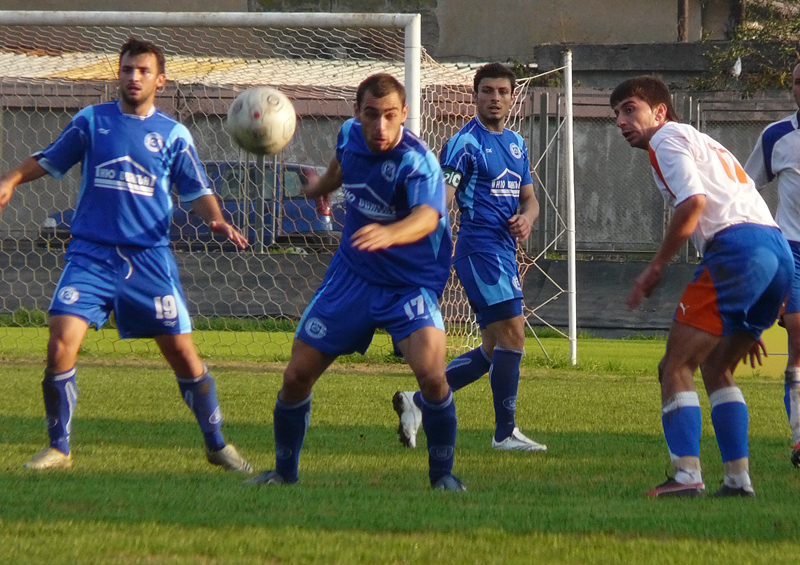



 *
*






Shooting Modes
The shooting modes are sufficient and usable by both experienced and beginner photographers. There are no differences with the previous models. Advanced photographers can choose between “Programmed”, “Aperture Priority”, “Shutter speed priority” and “Manual”. Beginners can choose between modes with predefined settings (shutter speed, white balance, color representation, sharpness, contrast etc.) according to the chosen subject – “Portrait”, “Beautiful Skin”, “Landscape”, “Sport”, “ Night Shot”, “Night portrait”, shooting with tracing a moving object and long exposure time, “Food”, “Party”, “Candle”, “Fireworks”, “Stars”, “Children”, “Snow” and lastly “High Sensitivity”. Video clips can be made with the DMC-FZ18 up to 2GB with a resulotion of 640x480 pixels, speed of 30 frames per second, along with sound. Video in 16:9 format is also possible with a resolution of 848X480 pixels, intended for TVs with the same format. Focal length cannot be changed during video recording which is a serious disadvantage and makes this model unusable for a home video camera.
* White Balance
With the white balance there is variety enough for photography. You have fully automatic mode, then “Sun”, “Cloudy”, “Halogen Lamps”, “Flash”, “Manual Settings”. Additionally, those modes can be manually configured very precisely with an interesting coordinating system. The Automatic White Balance of the Panasonic FZ18 is quite accurate and works perfectly even with artificial light.
* File Formats
The File Formats which can be written on SD, SDHC and MMC memory cards are on an up to date level – the necessary for important work RAW, JPEG with two types of compression – standard and fine and lastly MOV for video clips. I must point out again, that the speed of recording is quite good for such a camera and with a fast card in RAW it can reach almost 2 seconds per frame.
* Series of pictures
Series of pictures is not a strong point of the Panasonic FZ18. The speed of shooting is 2 images per second until the card is full.
* Picture Settings
The constructors of the DMC-FZ18 did not forget to make things easier for us if we need to change the structure qualities of a picture. With the menu you can change the contrast in 5 different ways, also sharpness, color saturation and noise reduction. We advise you to remember that if you expect the best results you should have the contrast and color on 0, and sharpness and noise reduction at -2. A combination of stronger noise reduction and sharpness, along with saturated colors and high contrast is good only for small prints for family albums and if you do not intend to retouch those pictures later. If images are shot with those lowered settings and you have chosen a subject feature (Portrait, Landscapes etc.) they need more retouching or post processing in Photoshop, without loss of quality. Of course the DMC-FZ18 can change the characteristics of the color representation. There is no problem to shoot in black and white, sepia, warm or cold tones.
* Handling the flash
The build-in Flash of the DMC-FZ18 can illuminate uniformly at 0,3-7m with wide-angle option of the lens and at 0,3m till 5,3 with the telezoom option, corrections are also possible – from +-2 EV through 0,3 EV. There is a feature for removing ‘red-eye’, entirely automatic, always on, always off and pictures with long exposure time. Unlike the FZ50, with the smaller models there is no nest for an additional flash. The small build-in flash is DMC-FZ18 works perfectly and provides a good balanced image. The following picture was shot with a flash mode “slow synchronization + red-eye correction”. The photo was taken at 1/10 sec, with switched on stabilizer, from hand, so that the background could be visible:

* Silkypix Developer Studio
As with the FZ50, the manufacturer has provided a free copy of a RAW format converter – Silkypix Developer Studio. With this converter or the Photoshop CS3 converter you have the possibility to convert the settings of the image the way you like them. Except for the standard settings there are change of exposure, white balance, sharpness and color saturation, the converter has a good noise reduction filter on many levels, so that in the end you get the clearest and sharpest image possible. It is easy to fix only the over-exposed parts of the image , there is also the possibility to use curves, a line can be drawn in the converter itself to change the size of the image, correction of software defects in the optics and even to imitate some film types. The best advantage of the converter is the possibility to extract the entire, useful information recorded on the matrix, usually big part of that information is lost when converting to JPEG in the camera. It turned out not so difficult to have details in the highlights even if over-exposed with 1-2f numbers with a RAW image. This is very useful when shooting landscapes when we want to have details in both shadows and highlights – sky, clouds etc. On the example below, you can see an over-exposed picture shot in JPEG, in which we have lost all the information for the sky and below it the same picture with corrections in the RAW file:


More than that when shooting in RAW, we can recover/extract maximum amount of details in the image. The difference is quite visible in details with fine structure, for which the noise reduction option in JPEG does nothing good. Here I must criticize the engineers of Panasonic, again. There is no need to increase the noise reduction option in the luminance channel when iso is 100 and 200. It is only necessary to slightly reduce color noise. Here is the picture at 100% crops at 28mm, shot from the fortress Mezek. On the left is the JPEG and on the right the RAW:
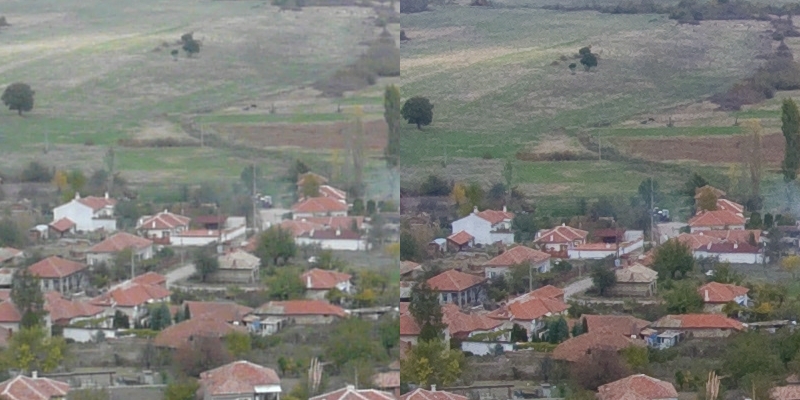
So, if you want to use RAW, you definitely should if you are planning to print, let’s say 60x40cm or if you have unusual lighting conditions, high contrast or low light. For the family album or 20x30cm the JPEG format is good enough.
When the light is enough, the tifference is not so visible. The picture is taken with 504mm., 1/160sec by hand :

Here are 100% crops - RAW and JPEG:
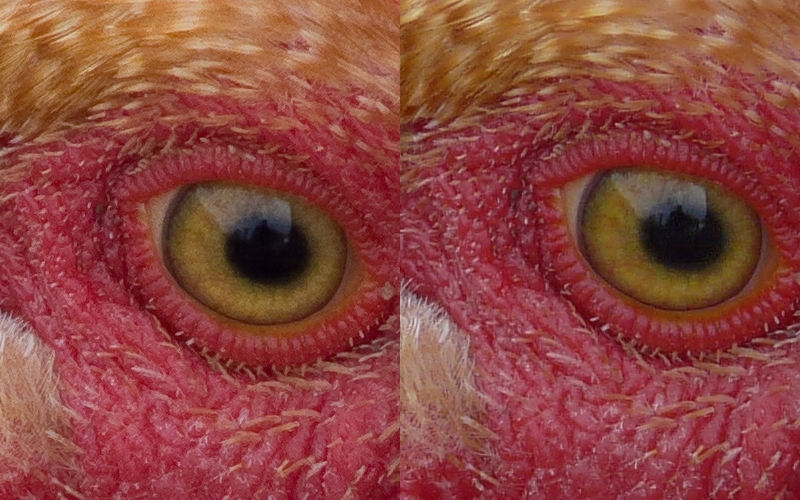
Noise and noise reduction.
Everything I can say about the noise is almost the same as in my review of the Panasonic DMC-FZ50. Panasonic DMC-FZ18 has a 1/2.5"8mp CCD. The size of the matrix and the high resolution are the reasons for the noise levels to be higher than they would be on a single lens reflex camera with a sensor of 23x15mm. At 100ISO FZ18 has almost the same amount of noise as a 10mp DSLR camera at 400-500ISO – such models like Nikon D80/ Canon EOS 400D/ Pentax K10D.
The new processor Venus Engine III is responsible for a great deal of noise reduction when shooting in JPEG. There is still a lot to be expected from the noise reduction algorithm. With good lighting there is no big difference in the details of the picture in RAW or JPEG, but with low lighting, especially in the shadows even at 100ISO there is considerable loss of details. More than that noise reduction with fine textures is also a problem – human facial skin or small details in the distance of a landscape. Despite the increased sharpness outline, the textures always turn out slightly blurred. In this case sharpening is not a good option. For prints 30x40cm it is acceptable though. If you need to print an enlarged image or to have better post-processing I strongly recommend using RAW format. If shooting in JPEG the settings of the noise reduction feature should be at – 2. When sensitivity above 200ISO is used the high noise reduction is considerably noticeable, unlike the FZ8 and FZ50 the manufacturers tried to preserve the color structure. They even succeeded with ISO of 400, but not really at 800 or 1600 ISO. The image is blurry and has almost no details. If you use RAW in those cases you would get favorable results. The JPEG at 400 and 800ISO can be used for photojournalism when you do not need to enlarge the image more than 20x30cm. The 1600ISO is good only for web usage or very small prints but needs good post-processing and noise reduction filters. Good prints in black and white of 20x40cm could also be possible with this sensitivity. If you want good results with JPEG you should shoot directly at 400 or 800ISO but use 100ISO with 2-3 f numbers underexposure and corrections in Photoshop.
The following example was shot in RAW and JPEG from 100ISO to 1600ISO. Lighting is low. A tripod is used. You can the way noise reduction affects image sharpness in JPEG

At the end of my review I will post a zip file with those examples in full size, for people who would like to examine them carefully.
Here is an example at 400ISO, shot in actual conditions and low light

Parts of 100% JPEG and RAW. It is good to know that the JPEG file is with ‘standard’ compression not ‘fine’

I should remind you that those are parts of extremely enlarged images (approximately 120cm in width). Good prints not more than 60x40cm are possible with RAW 100 and 200ISO. 400ISO is good for prints 30x40cm, 800ISO for 20x30. Color image at 1600ISO can be used for the web or after good post-processing and noise reduction filters for small prints. Nevertheless, if black and white the images can be enlarged more.

The following example demonstrates the 800ISO in standard lighting. Sometimes we have to increase the sensitivity even in standard lighting conditions if we want to shoot moving objects like birds, animals, sports etc.

100% crop :

As I was saying, with that sensitivity you cannot expect much, but if you shoot in RAW and then post-process carefully you could get an averagely good print 20x30cm.
More pictures shot in different conditions and options of the FZ18.
100ISO, 1/320sec, F3.6, 28mm

100ISO, 1/160sec, F3.6, 100mm

200ISO, 1/60sec, F3.6, 140mm

100ISO, 1/320sec, F4.2, 504mm

100ISO, 1/200sec, F4.2, 504mm

100ISO, 1/200sec, F4, 360mm

100ISO, 1/400sec, F5.6, 100mm

100ISO, 1/1600sec, F3.6, 400mm

100ISO, 1/320sec, F3.6, 180mm

800iso, 1/125sec, F4.2, 504mm

400ISO, 1/200sec, F4.2, 504mm

200ISO, 1/125sec, F4.2, 504mm

200ISO, 1/200sec, F4.2, 504mm

100ISO, 1/100sec, F2.8, 28mm

100ISO, 1/50sec, F3.6, 230mm

100ISO, 1/200sec, F3.6, 120mm

100ISO, 1/100sec, F3.6, 240mm

400ISO, 1/250sec, F4.2, 504mm

100ISO, 1/100sec, F3.6, 28mm

100ISO, 1/100sec, F3.6, 28mm

100ISO, 1/20sec, F3.6, 100mm

400ISO, 1/5sec, F3.6, 120mm

400ISO, 1/125sec, F3.2, 60mm

400ISO, 1/60sec, F3.6, 120mm

100ISO, 1/80sec, F3.6, 120mm

100ISO, 1/20sec, F3.6, 120mm

100ISO, 1/50sec, F3.6, 120mm

100ISO, 1/200sec, F3.6, 60mm

100ISO, 1/200sec, F4.2, 504mm

100ISO, 1/120sec, F4.5, 100mm

100ISO, 1/640sec, F4.2, 504mm

200ISO, 1/50sec, F4, 450mm

100ISO, 1/160sec, F4, 440mm

100ISO, 1/50sec, F3.6, 120mm

100ISO, 1/320sec, F3.6, 300mm

100ISO, 1/160sec, F4.2, 504mm

100ISO, 1/500sec, F5, 504mm

100ISO, 1/320sec, F3.6, 170mm

100ISO, 1/200sec, F3.6, 350mm

100ISO, 1/100sec, F3.6, 120mm

100ISO, 1/30sec, F3.6, 150mm

100ISO, 1/8sec, F3.6, 35mm

100ISO, 1.6sec, F3.6, 120mm

100ISO, 1/50sec, F3.6, 250mm

100ISO, 1/200sec, F3.2, 50mm

400ISO, 1/60sec, F3.6, 100mm

100ISO, 1/160sec, F6.3, 280mm

To sum up – The Panasonic FZ18 is a very good amateur camera, which covers almost every photographic situation in everyday life. The camera is suitable for people who like to travel a lot and wish to carry a small and compact camera with a wide range zoom lens. With this camera you can easily photograph different scapes of the big city – buildings, street portraits, details, events etc. The zoom lens covers focal lengths from 28 to 504mm, it can even reach 800mm at 3mp. With the fast RAW format you could shoot various landscapes. After that, post-processing in a RAW converter provides you with various possibilities to heighten the resolution and dynamics of the picture so that you can make quality prints up to 60x40cm. The 400ISO is quite useful and in combination with a perfectly good stabilizer you can make good photos in low lighting – night shots of a city, cathedral, church, museum etc. This type of camera can also be used to make good sports shots or wild life photos, with quality not comparable to an SLR camera but acceptable for an amateur photographer. Do not forget that with that type of photography (wild life) you need an SLR camera with fast tracing AF and high quality at a higher sensitivity along with quick wide aperture lenses.
My only criticism is for the quality of JPEG images, more precisely the unbalanced levels of noise reduction, which destroy fine details even in 100ISO. It is about time Panasonic invested in some serious upgrades of the camera software. If that is impossible for them, then they should put an option for switching off the noise reduction entirely. We can do it(noise reduction) on our own with suitable software. In addition, I can give you the following advice – if you wish to make small prints or at 100-200ISO not more than 30x40 (at 400ISO not more than 20x40cm, at 800ISO – 10x15cm) then you can use JPEG. You won’t have any troubles with quality. But if you want high quality large prints you should shoot in RAW.
Advantages and Disadvatanges:
+ High Quality Lens, sharp with every f number. Slight blurring at 504 mm.
+ Wide Range Vario – from wide-angle 28mm to telezoom 504mm (800mm at 3mp)
+ High resolution image at 100 and 200ISO
+ High quality 2.5 inches display
+ Manual focus
+ Smart control of the sensitivity
+ Efficient optical stabilizer
+ Precision in light metering
+ Very good color representation
+ Focus lock and/or exposure until cancellation
+ Histogram in actual shooting time
+ Good automatic white balance
+ Fast and exact AF, usable AF with face recognition
+ Fast RAW format and very useful convert software(which comes in the package)
- Excessively strong noise reduction when working in JPEG even at low sensitivity, along with loss of detail in shadows or midtones of the image.
- The display does not rotate in any direction
- Enormous RAW files– 13-15mb
- Low speed with series of pictures
- Raw is not an option when shooting series of pictures. I strongly advice Panasonic to work on a buffer and compressed RAW format in their next model.
- There is no tracing AF mode. The tracing AF is only available halfway through pressing the shutter button.
From here you can download the ZIP file with the full size pictures I used in the review taken in JPEG or converted from RAW. Examine them carefully and not only on the monitor but print them on paper and see if Panasonic FZ18 is the best choice for you.
B.Bonev '2007


